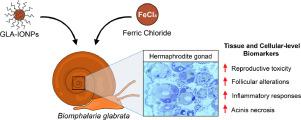Aquatic Toxicology ( IF 4.5 ) Pub Date : 2021-07-10 , DOI: 10.1016/j.aquatox.2021.105910 Cândido Carvalho Rodrigues 1 , Maxwell Batista Caixeta 1 , Paula Sampaio Araújo 1 , Bruno Bastos Gonçalves 1 , Olacir Alves Araújo 2 , Luciana Damacena Silva 3 , Thiago Lopes Rocha 1

|
Considering that most animals in an aquatic ecosystem are invertebrates, concerns about the ecotoxicological impact of emerging pollutants, such as nanomaterials, in these populations are relevant, which can lead to loss of aquatic biodiversity. However, knowledge concerning the effects of iron-based nanoparticles (IONPs) at cell and tissue-levels on freshwater gastropods remains limited. Thus, the present study aimed to analyse the histopathological changes and inflammatory response in the freshwater snail Biomphalaria glabrata after chronic exposure to gluconic-acid functionalized IONPs (GLA-IONPs) in comparison with their dissolved counterpart (FeCl3). Snails were exposed to both iron forms (1.0, 2.5, 6.25, and 15.62 mg L−1) for 28 days, and the qualitative and quantitative histopathological assessment on hermaphrodite gonads was conducted, following by analysis of histopathological indices and inflammatory responses. Results showed that both iron forms (GLA-IONPs and FeCl3) induced several gonadal histopathologies in the snails, mainly atresic acini, vacuolization of pre-vitellogenic oocytes, and atresic oocytes in a concentration-dependent pattern. GLA-IONPs induced a more intense inflammatory response and high frequency of vacuolized vitellogenic oocytes in comparison with FeCl3. Environmentally relevant concentration (2.5 mg L−1) of GLA-IONPs and FeCl3 induced high gonadal histopathological indices, indicating their potential reproductive toxicity. The current study showed that the chronic exposure of snails to GLA-IONPs and their dissolved counterpart (FeCl3) induced several gonadal histopathological changes and inflammatory responses in B. glabrata, confirming their potential risk to aquatic biodiversity.
中文翻译:

暴露于氧化铁纳米颗粒和氯化铁的淡水蜗牛的性腺组织病理学和炎症反应:对生殖纳米毒性的洞察
考虑到水生生态系统中的大多数动物是无脊椎动物,对新出现的污染物(如纳米材料)对这些种群的生态毒理学影响的担忧是相关的,这可能导致水生生物多样性的丧失。然而,关于铁基纳米粒子 (IONPs) 在细胞和组织水平上对淡水腹足动物的影响的知识仍然有限。因此,本研究旨在分析长期暴露于葡萄糖酸功能化 IONPs (GLA-IONPs) 与溶解对应物 (FeCl 3 )后淡水蜗牛Biomphalaria glabrata的组织病理学变化和炎症反应。蜗牛暴露于两种铁形式(1.0、2.5、6.25 和 15.62 mg L -1) 28 天,对雌雄同体的性腺进行定性和定量的组织病理学评估,然后分析组织病理学指标和炎症反应。结果表明,两种铁形式(GLA-IONPs 和 FeCl 3)在蜗牛中诱导了几种性腺组织病理学,主要是闭锁腺泡、前卵黄母细胞的空泡化和浓度依赖模式的闭锁卵母细胞。与 FeCl 3相比,GLA-IONPs 诱导更强烈的炎症反应和高频率的空泡化卵黄生成卵母细胞。GLA-IONPs 和 FeCl 3 的环境相关浓度 (2.5 mg L -1 )诱导高性腺组织病理学指标,表明其潜在的生殖毒性。目前的研究表明,蜗牛长期暴露于 GLA-IONPs 及其溶解的对应物 (FeCl 3 ) 会在B. glabrata 中引起几种性腺组织病理学变化和炎症反应,证实了它们对水生生物多样性的潜在风险。



























 京公网安备 11010802027423号
京公网安备 11010802027423号